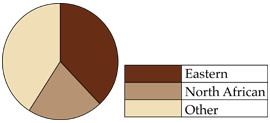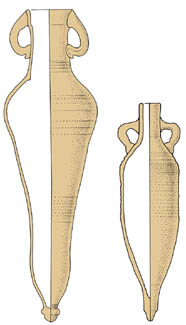- Glass Making in Roman Times
- Roman Wine: A Window on an Ancient Economy
- Roman Wine: Windows on a Lifestyle
- Fine Glassware in the Roman World
- Reuse of Images in the Art of Rogier van der Weyden
4th Century Crises

Late 4th/early 5th century A.D.

Left: Egloff 172 amphora
Capacity: 4 choes [5.0 U.S. gallons]
Right: Egloff 177 amphora
Capacity: 1 chous [1.25 U.S. gallons]
Even though the Rhine frontier was fully restored by the turn of the 4th century A.D., the agricultural landscape of Gaul was then in pretty poor shape. When the emperor Constantine visited Augustodunum (Autun) in A.D. 312, he was told that the soil of the Cote d'Or was choked by a tangle of old vine roots, that the vines themselves were old and exhausted, and that the roads of the area were so potholed that wagons could scarcely bear half a load with safety. The vintners of the Rhone valley were no longer in a position to produce enough surplus wine to export strongly to anywhere, not even the ever-thirsty city of Rome.
Vintners of the eastern Mediterranean were able to pick up much of the slack for both Italy and Gaul from then on. The increased acceptance of eastern Mediterranean wine in the West from the 5th century A.D. onwards mirrors well the impact of fresh barbarian invasions that once again engulfed Rome's northwestern provinces. The Germanic Vandals had swept across the Rhine frontier in A.D. 375, and cut a fiery swathe through Gaul and onwards to northern Africa where, in A.D. 439, they settled at the port of Carthage. From there, well-organized piracy gave the Vandals control on the seas of the western Mediterranean, so Rome lost the precious grain and oil by which it had taxed its north African provinces for centuries past. The cargoes of eastern wine that now flowed easily into an affluent Carthage were predominantly eastern in origin, including not only particularly popular Gaza vintages [see Gaza Story], but also those of Antioch and Sardis. Production levels in Egypt then were running at a sufficient surplus to satisfy both Alexandria's domestic needs and to allow for some exportation to Carthage as well.
